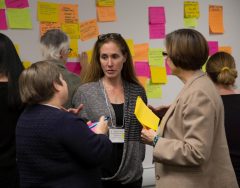by Chelsea Nash, CFICE Communications Research Assistant
There are many things to consider in advance of preparing and submitting your application for a SSHRC Partnership Grant. This month, CFICE has taken a look back at its own SSHRC application process and we have attempted to share some of the lessons we’ve learned along the way. This is the fourth article in our SYWASPG (So You Want to Apply for a SSHRC Partnership Grant) series. See our other stories on whether or not the SSHRC Partnership Grant is right for you, how to respectfully involve your community partners in the application process, and the ins and outs of Project Work Plans and Budgets.
It’s no secret that with at least a dozen university partners and more than 60 community partners, spanning the course of seven years and across the country, the CFICE project has been—and continues to be—a pretty massive undertaking.
That’s not to say that it’s in any way better than a smaller partnership project that might have one or two or even three partners. Determining the size and scope of your research project really depends on your objective. Think of a bow and arrow. Your research question is the bow; your answers are the target. How many arrows will it take for you to hit your target? Repeatedly? In such a way that you can then pass what you have learned about your target onto the next archer? (Don’t forget, at the end of the day, a SSHRC Partnership Grant is indeed about funding the production of academic knowledge.)
CFICE’s current Principal Investigator (PI), Peter Andrée, says that CFICE “was appropriately-sized for its long-term objective, which was to identify ways to maximize the value of community-campus partnerships for the non-profit sector, and to further efforts to institutionalize what we’ve learned.” In other words, CFICE aimed to strengthen the Community-Campus Engagement movement as a whole in Canada. In order to do so, including partners from across a range of sectors and across the country was an appropriate—if lofty—goal.
But, that doesn’t mean that CFICE’s large size did not present some challenges.
The challenges of a multi-partner and large-scale research project
Within a multi-partner project with limited funds, there is only so much money to go around. Of course, the more partners you include, the thinner those funds must be spread.
“Our degree of engagement with specific partners really varied,” said Andrée of CFICE, which led to some community partners noting that the partnership ultimately had “limited impact” on their capacity or projects. In some instances, partners might have only received five thousand dollars, and limited follow-through.
If having many partners suits your project, then having open and honest communication about your project’s capacity and priorities can help to ensure that everyone has reasonable expectations for the project.
The CFICE team included community partners in a participatory budgeting process, which helped facilitate this communication in a more structured setting. Additionally, CFICE expanded its secretariat, because, as Andrée said, “project management, administration, and communications need to be especially strong in a large project that seeks to communicate with a broad network.”
The allocation of more time and resources into funding-related decision making can also be a downfall of a larger partnership project, as it means more costs are allocated to central administration. As Genevieve Harrison, CFICE’s Project Administrator, puts it, the process of allocating resources among many partners can also be “time consuming and contentious.”
“Partnerships that are smaller in scope can be more efficient in terms of communication and decision making,” said Harrison, though smaller partnerships can be subject to different constraints. For example, Harrison mentioned that, “Organizing a group with fewer players often is easier, unless those players have restricted time available to participate.”
Harrison spoke to how the issue of resources is generally a challenge regardless of the size of the partnership. The issue of insufficient compensation for community partners “is felt by both community partners and their academic counterparts,” Harrison said. “This is in part due to the fact that SSHRC funds opportunities for academics and students, and although it is aware of the need to fund community partners in research, does not see it as part of their mandate.”
While a larger research project generally presents the hurdle of coordinating and clearly communicating with many partners that are potentially spread across the country, that same large network can provide unique benefits, too.
The benefits of a multi-partner, large-scale research project
Large partnerships offer a wide network, which can then “offer exposure to a larger pool of participants that ultimately develops priorities for research that meet the needs of a larger community,” said Harrison.
As a result of having a larger research network, your project might create more “noise as partners assist in spreading the word about the research to a larger audience,” said Harrison. This noise or increased attention to your project can help to generate “larger in-kind contributions to the work and they can offer a greater variety of project resources,” Harrison added.
For CFICE, its large size meant it was able to engage a wide range of partners, including academics, institutions, students, and community organizations. Andrée attributes the large scale and scope of the project to the project’s ability to help “expand and extend the reach of thinking about community-campus partnerships.”
To make the most of a large-scale research project like CFICE, Andrée says its important to “do it with eyes wide open,” and be realistic about what you can promise your partners. “Find a partnership direction that fits the aspirations and needs of your wide partnership,” he said, and develop your project governance structure early on, and with input from with your partners.
Regardless of how many partners you have, or the physical distance that separates you, there are unique challenges and benefits that come with having both smaller and larger CCE partnership projects. Mindfully managing expectations, communicating thoroughly and openly, and being realistic about the resources you have available are important to addressing some of these challenges.


